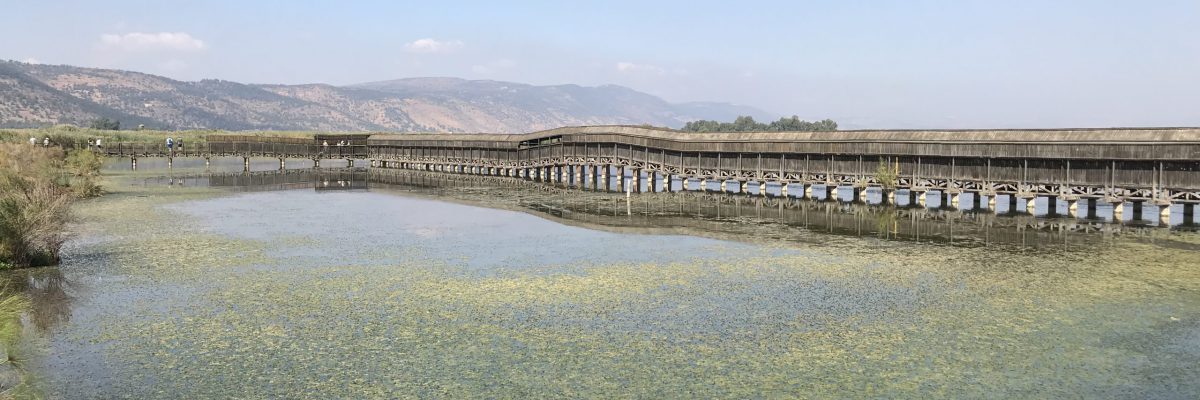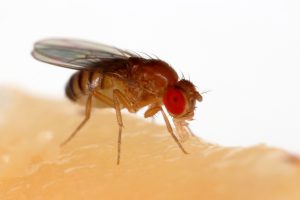Abstract
Since the mid-1990s, the domination of the bloom-forming Peridinium spp was replaced by Cyanobacteria in Lake Kinneret (Israel). It is suggested that the efficiency of Nitrogen utilization by Peridinium is dependent on ammonium availability. Furthermore, the external supply of ammonium into Lake Kinneret is dependent on the anthropogenic management of the Hula Valley.
Anthropogenic management of the Hula Valley
The Kinneret drainage basin area is 2730 km2, located mostly to the north of the lake of which the Hula Valley is about 200 km2. Three major headwater rivers flow from the Hermon mountain region and join into one river Jordan. Jordan River contributes about 63% of the Kinneret water budget. Before 1957 when the Hula Valley was drainage, this land was covered by old Lake Hula and 3500 ha of swampy wetland. Not much information was documented about the chemical composition of the Kinneret headwater, the Hula Valley wetlands and old Lake Hula before the drainage. The Hula swampy wetlands and the old Lake Hula were drained between 1951 and 1957. From 1851 to 1957, about 40 scientific expeditions explored the fauna and the flora of the wetland and temperature, pH, Chloride concentration, and Hardness in old Lake Hula and river waters in the Hula Valley. Nevertheless, information about nutrients in the swamps and the old Lake Hula is not available (Dimentman et al. 1992). A single documented analysis (Jones 1940 a,b) reported free and albuminoid Ammonia concentrations in the swamps and old Lake Hula whereas Nitrate and Nitrite were absent or unmeasurable. The higher concentration of Free and Albuminoid Ammonia in the swampy waters and lower in old Lake Hula were reported. Consequently, the reductive environment of the swamps is confirmed (Dimentman et al. 1992).
Historical Land-Use Milestones
The indication of the Hula Valley as a wilderness was defined by the Mongolian (1240 ac) and Malaria was introduced during the Crusader period (1099-1291 ac). Enhancement of Water surface inundations of the swamps and old Lake Hula resulted in the construction of the Benot Yaakov bridge by Bivers in 1260. The principal impact on human activity was due to the distribution of the Malaria disease. Settling of the Ghawarna nomad tribes in the Hula Valley was carried out from 1840 and 1948 while the nomad population increased from 520 to 31,470 residents. No permanent settlements were constructed and the management policy principle was “the more dry was the winter more grass for cattle grazing and land for agriculture were available in spring-summer season”. The Jewish settlements in the Hula Valley were initiated at the end of the 19th century and enhanced in the 1940s. The drainage of Old Lake Hula and adjacent swampy wetlands was carried out from 1950 to 1957. The old lake and wetlands area was converted into agriculture and 6900 ha of natural wetland were converted to agricultural cultivation. Consequently, natural fauna and flora of exceptional diversity were demolished. For 40 years, agricultural products (Cotton, Corn, Alfa – Alfa, vegetables Barley and others) were economically produced. As a result of inappropriate management, soil structure deteriorated, dust storms became frequent, soil surface subsided by 7-10 cm/year, and underground fires occurred frequently. A reclamation project was implemented (1994-2005).
The reclamation project included creating a new shallow Lake Agmon-Hula, (presently 0.2 m mean depth, and 82 ha surface area) functioning as a collector of flushed nutrients from the peat soil to be removed through the Agmon-Hula system out of the Kinneret watershed. Independently human domestic sewage and dairy-farming effluents removal projects were achieved. Collected sewage is transferred into treatment plants and stored in reservoirs for irrigation reuse. From 1970 to 1985, the fish-pods area in the Hula Valley was restricted from 1700 to 300 ha. Sewage removal and fish-pond restriction eliminated significant loads of nutrients, mostly organic Nitrogen, and ammonium, from the external inputs into Lake Kinneret. As a result of the drainage (1957) dominated Nitrogen form contributed by the Hula Valley shifted from ammonium and Organic to Nitrate which represented continuously stable and high concentration. Not like high and stable concentrations of Nitrate, Organic Nitrogen and ammonium forms significantly declined. The Nitrate flush dynamic resulted from dryness and oxidation of the Peat soil after the drainage. The decline of Organic Nitrogen and ammonium is attributed to sewage removal and diminished aquaculture.
Sewage Removal
As of 2007, 18 reservoirs with a total available volume of 4.1 106 m3 were constructed in the Kinneret watershed. Earlier, 12 x106 m3 of raw sewage entered annually into Lake Kinneret. Between 1996 and 2007, a total capacity of 83 tons/year of TN (concentration 11-27 ppm) (data on Ammonium is not available) was removed into reservoirs whilst the annual capacity of TN was removed through the Agmon-Hula system (concentration 4.6-8.7 ppm) varied between 11-48 ton/year. Removal of ammonium load (mean concentration 1.4 ppm) through the Agmon-Hula system during 2000-2005 varied between 5.5 and 3.3 ton/y. Prior to the implementation of the sewage removal project in 1986, an annual load of Ammonium in the Jordan discharge was 70.2 tons whilst from 1999 to 2018 the mean capacity of ammonium in the Jordan was 21 tons, and the mean loads of Nitrate was 718 tons. Consequently, ammonium removal from the Kinneret mass balance through sewage treatment, as measured in the Jordan discharge is more efficient than through the Agmon-Hula system. Nevertheless, heavy loads of Nitrates originated in the Peat-soil, enriched lake Kinneret TN standing stock. Before the drainage, about 293 ton/y of free ammonia were delivered from the swamps into old Lake Hula and 117 ton/y of Albuminoid ammonia were forwarded from the old Lake Hula into the Jordan (annual discharge 650 mcm,=106 m3) (Dimentman et al. 1992; Jones 1940 a, b).
According to reported information (Kinneret Authority 2004; Upper Galilee Organization – Monitoring Effluent Reservoirs 1996-2007) total sewage volume that was practically removed was 7.2 mcm out of the optional available17.1 mcm (42%) of which 1.6 mcm were spilled over and 5.6 mcm (33%) were reused and eliminated from Nitrogen consumers in Lake Kinneret. An average of 19 ppm as the concentration of TN in the sewage removed into reservoirs indicates the elimination of 106 tons of TN of which mostly is Organic and ammonium Nitrogenic material. Prior to the Hula Drainage Nitrates were almost absent (Dimentman et al. 1992; Jones 1940 a, b) or negligible within the Jordan loads. Before drainage Jordan River conveyed 2.3 times more ammonium than from 1985 to 1967 and 5.6 times more than 1999 to 2018. After the drainage, Peat soil oxidation was enhanced and nitrates became the major Nitrogen form within the Jordan supply to Lake Kinneret. Before sewage removal accomplishment, the flux of Organic Nitrogen and ammonium continues for the benefit of nitrogen consumers (mostly Peridinium) in Lake Kinneret. After the achievement of sewage removal and aquaculture restriction loads of Organic Nitrogen and ammonium declined and the Peridinium bloom diminished.
Peridinium and Nitrogen Relationships in Lake Kinneret
The Nitrogen demand by Peridinium for optimal growth rate was widely
documented earlier (Gophen 2015; Gophen et al. 1999; Pollingher et al. 1978; Nishri 2011; Nishri and Hamilton 2011; Serruya and Pollingher 1971; Serruya et al. 1980). Maximal concentrations of ammonium in the Kinneret Epilimnion during the Peridinium Bloom season vary between 1.1-1.7 µM which promptly decline later. Ammonium decline is due to algal uptake and microbial nitrification. Considering 3% of dry weight as Nitrogen content in Peridinium cells and 40% as DW of Wet Weight and the commonly documented peak of 150 g(ww)/m2 ( Pollingher et al. 1978; Serruya et al. 1980) the total Nitrogen requirement to compensate the standing stock is about 30000 tons for the entire lake (168 km2 and 2000 mcm, Epilimnion volume). Considering ammonium preferential uptake on Nitrate (Dortch 1990), the standing stock is insufficient. Therefore, the Peridinium preferential ammonium is a limiting factor although partly replaced by plenty of available Nitrates. The high concentration of Nitrate in early winter is due to the flux of Nitrate and substantial bacterial nitrifiers originating from the Hula Peat soil. The Nitrogen sources supplied for the Peridinium bloom formation are mostly external although the significant stock of Nitrogen is trapped in the bottom sediments (Serruya et al. 1980). The prominent decline of the external supply of Organic Nitrogen via headwater discharges (River Dan, River Jordan) since the early 1980s was documented (Nishri 2011; Nishri and Hamilton 2010). Sewage removal and Fishponds restriction probably enhanced this trend. A similar decline was also documented in the Golan Heights Meshushim headwater discharge (Nishri 2011). During the late 1970s and early 1980s there was a prominent decline in Nitrate at the expense of the Nitrification bacterial process. It was considered (Nishri and Hamilton 2010) as enhanced Phytoplankton Nitrate uptake of which biomass was prominently increased. Nevertheless, a simultaneous high concentration of ammonium was indicated as well. The optional uptake competition by Peridnium between ammonium and Nitrate was not considered. A worldwide well-known tenet indicates that ammonium inhibits nitrate uptake (Kanda et al. 1990) and a low rate of nitrate uptake occurs when ammonium concentration is above 1µM and ammonium is preferred as a nitrogen source although growth rates on nitrate continue (Dortch 1990; Smith et al. 2014; Kanda et al. 1990). Ammonium supply to the Kinneret Epilimnion in early winter originates mostly from the Hypolimnion into the Epilimnion during de-Stratification which promptly declines while being oxidized to Nitrate. The ammonium decline is attributed to algal uptake and microbial nitrification. During the Peridinium bloom, the Epilimnetic (app volume 2000 mcm; 106m3) ammonium mean concentration varies between 0.020 and 0.030 ppm (1.1-1.7 µM) which is a total Epilimnetic stock of 40-60 tons. The standing stock of intracell Nitrogen content within the Peridinium biomass is 30000 tons resulting in ammonium insufficiency and Nitrate is utilized instead. If ammonium concentration is higher than 1µM, it is preferred but if lower – Nitrate is incorporated. Prior to the sewage removal and aquaculture restriction, ammonium supply probably compensated nitrogen demands by Peridinium. Later on, when Nitrogen supply originates mostly from nitrate the Peridinium decline became realistic. Prior to 1957 ammonium was efficiently supplied from the reductive swampy environment for the beneficial Peridinium bloom formation. Later on, sewage and aquaculture became major ammonium suppliers, and further, when the major nitrogen source was Nitrate the Peridinium declined. Nishri and Hamilton (2010) considered direct relation between phytoplankton biomass and Nitrates whilst competition and ammonium preference are not involved.
Conclusive Remarks and Future perspectives
1: Hula Drainage initiated a shift from organic and ammonium nitrogen to Nitrate supply which induced the replacement of Peridinum by Cyanobacteria domination.
2: Long-term process of Nitrogen decline in the lake Kinneret Epilimnion induced the diminishment of Peridinium as confirmed by its seasonal renewal during heavy rainfall events and its local blooming along the shoreline where decomposed vegetation enriched the nearby waters with organic and ammonium nitrogen.
3: The design for long-term Peridinium bloom renewal supportive ammonium and organic Nitrogen supply by enhancement of anoxic level in Lake Agmon-Hula is recommended.
Reference
Dimentman, Ch., H.J. Bromely and F. D. Por, 1992, Lake Hula, Reconstruction of the Fauna and Hydrobiology of a Lost Lake; Publications of the Israel Academy of Sciences and Humanities, 170p (Brief Summary in Hebrew 24p.).
Jones, R. F., and Washbourn, R. 1940 a, Report of the Percy Sladen Expedition to Lake Huleh: A contribution the study of the Fresh – Waters of Palestine.-Part II. The Flora. J.Bot. Lond. 78 (936): 273-283.
Jones,R.F., (1940 b,) report of Percy Sladen Expedition to Lake Huleh: A contribution the study of the Fresh – Waters of Palestine. I. The plant ecology of the district. J. Ecol. 28:357-376.
Gophen, M., Smith, V.H., Nishri, A. and Threlkeld, S.T. (1999) Nitrogen Deficien- cy, Phosphorus Sufficiency, and the Invasion of Lake Kinneret, Israel, by N2-Fixing Cyanobacterium Aphanizomenon Ovalisporum. Aquatic Sciences, 1, 1-14. https://doi.org/10.1007/PL00001326
Gophen, M. (2015) The Impact of Available Nitrogen Deficiency on Long-Term Changes in the Lake Kinneret Ecosystem. Open Journal of Ecology, 5, 147-157.
Nishri, A. 2011; Long-Term Impacts of Draining a Watershed Wetland on a Downstream Lake, Lake Kinneret, Israel; Air, Soil and Water Research 2011: 4, 57-70. Doi:10.4137/ASWR.S6879
Nishri, A., and D. P. Hamilton, 2010; A mass balance evaluation of the ecologicxal significance of historical nitrogen fluxes in Lake Kinneret; Hydrobiologia (20`10) 655: 109-119, DOI 10.1007/s10750-010-0408-3
Serruya, C. and Pollingher, U. (1971) An Attempt at Forecasting the Peridinium Bloom in Lake Kinneret (Lake Tiberias). Verhandlungen des Internationalen Verein Limnologie, 19, 277-291.
Pollingher, U. T. Berman, W. Rodhe and Serruya, C. (1978) Chapter: Peridinium: cinctum fa westii (Lemm) Lef. In: Lake Kinneret Monographiae Biologicae, Vol. 32, Junk Publishers, pp 259-295.
Serruya, C., M. Gophen, and U. Pollingher. 1980. Lake Kinneret: Carbon Flow Patterns and Ecosystem Management. Arch. Hydrobiol. 88(3):265-302.
Dortch, Q. 1990, The interaction between ammonium and nitrate uptake in phytoplankton. Marine Ecology Progress Series, Volume 61: 183-201.
Smith, J. M., F. P. Chaves, and C. A. Francis, 2014, Ammonium uptake by phytoplankton regulates nitrification in the Sunlit Ocean. PLoS One, 2014; 9 (9): e108173. Doi: 10.1371/journal.pone.0108173
Kanda, J., D., A., Ziemann, L., D., Conquest and P., K., Bienfang, 1990, Nitrate and ammonium uptake by phytoplankton populations during the spring bloom in Auke Bay, Alaska, Estuarine, Coastal and Shelf Sience Volume 30, Issue 5, May 1990, pp 509-524. https://doi.org/10.1016/0272-7714(90)90070-8Get rights and content.








